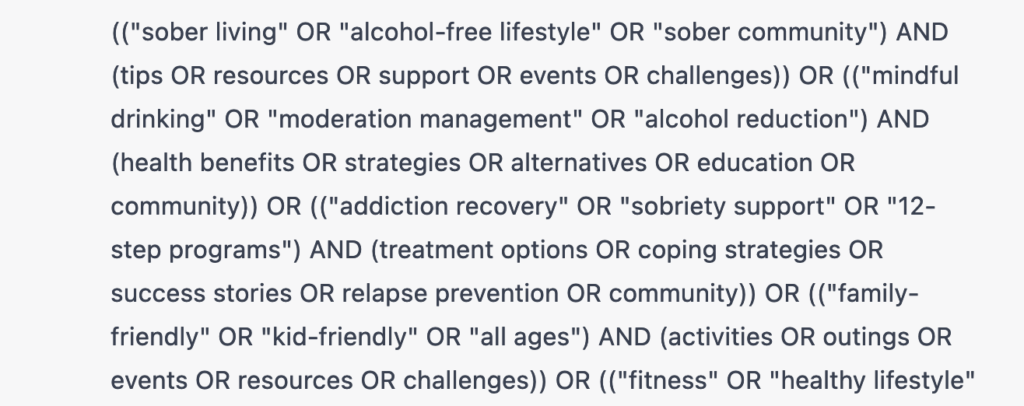Throughout the end of Summer and Autumn, I created a search around “Pumpkin Spice’ across social media to help understand if we had passed peak pumpkin spice or if the Autumn beverage trend was still on the up.
Using the social listening tool YouScan, I analysed 950k posts across Twitter, Facebook, TikTok, YouTube and Reddit. These are the results.
Why did I decide to do this? Because 2023 is the 20th anniversary of Starbucks launching the Pumpkin Spice Latte. I wanted to understand if this behemoth of a seasonal trend was still growing with each passing year or if its time was done.
Is Pumpkin Spice Even Still a Thing?
Due to social listening constraints, the only platform that we can easily access full historical data for is Twitter/X. I’ve pulled mentions of pumpkin spice from January 2020 until now and as you can see, there’s been a strong upward trajectory. This year, we’ve seen slightly fewer tweets, but it could be argued this has more to do with the mass exodus from Twitter than a lack of pumpkin spice love.
The interest in pumpkin spice peaks each year around the same time; this is usually around the end of August on the first day that the Fall menu is available at Starbucks.
When did people start talking about it this year?
Looking at the social data across all tracked platforms from this year specifically, you’ll see it was late August when the conversation really got started, with two prominent peaks in this month, one for Dunkin’s launch on August 16th and one for Starbucks on August 24th. After the initial excitement died down, the conversation remained pretty consistent throughout September, peaked again on October 1st and began a steady decline from there; by the time we hit early November, the chatter had almost dried up (due in no small part to the release of the Starbucks/Dunkin holiday menus).

The vast majority of this conversation was driven by America. When I dived a little deeper into the UK-specific data (primarily from X) I found that our conversational peak was much later (late October) and driven primarily by a pumpkin spice-themed B&M competition.
Channel Mentions vs Engagement
Looking at the data from the end of August this year until now, we can see that Twitter/X is still the clear leader when it comes to posting your pumpkin spice-related content, with 469k posts being made on the platform in the last three months.
However, when we look at where the engagement is happening, it’s a wildly different story. Although TikTok only accounted for around 150k original posts, it delivered over 220 MILLION engagements. Twitter/X on the other hand managed just under 4 million impressions on three times the number of original posts.
YouTube was also a channel people took to when sharing their Pumpkin Spice content, and here, the engagements were more in line with what we would expect.
You’ll note that there’s no Instagram data, and this is due to Meta’s API confines that make geo-specific searches impossible.
What are People talking about?
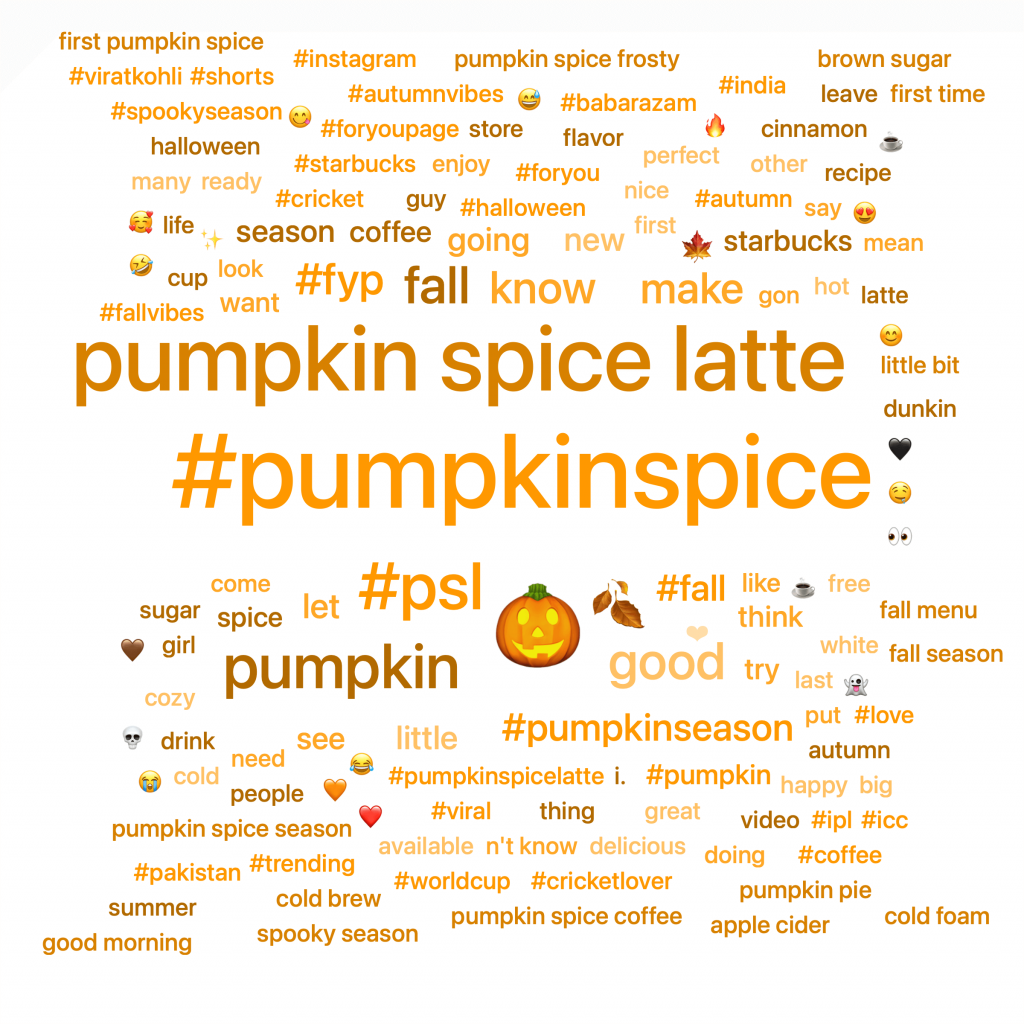
Although #pumpkinspice was the most used hashtag, the OG ‘Pumpkin Spice Latte’ still dominates the online conversation around the season.
What were some of the biggest trends this year?
Using YouScan, I was able to easily identify what some of the top trends in this year’s pumpkin spice- themed conversation were.
The video ‘White Women ordering Pumpkin Spice Coffee’ was the most talked about trend of the season, primarily due to its incendiary nature. Although it was extremely popular and many people found it funny, it was also called racist and drove a wider conversation around double standards.
Another notable talking point was around Ed Sheeran working a shift in Starbucks to promote his new record “Autumn Variations”.
Given his superstar status, this drove a lot of conversation.
Although some users were into this, many posts were around millionaire celebrities doing working-class cosplay to sell more records.
One of the biggest user-generated trends of the season was ‘Summer is Dead, Pumpkin Spice Forever’, a celebration/call to arms for the (huge) online community who anxiously await the month of October and the official beginning of Fall.
There is a massive crossover between this community and the Halloween community. Almost 10% of the mentions in this whole search mentioned Halloween by name.
Interestingly, although this community is voracious about their love of all things Autumn, relatively few brands have capitalised on this, and those that have are primarily in the food and drink space.
Is it still basic to drink PSL?
Out of the 950k posts that we analysed, only 23k of them mentioned ‘basic’ in any capacity, and more surprising still, there was much less negativity associated with the term. Most posts were either neutral or celebrated the creators ‘basic’ status.
However, there are still hundreds of posts from men talking about basic white girls in conjunction with Pumpkin Spice, so anti-feminist trolling is still very much a thing.
Who is the Audience?
Although it’s commonly thought that it’s just women who are the driving force behind Pumpkin season, you’ll see that posts from men are almost as common. The biggest contributor by far though is ‘other’ which usually indicates posts from creators and from brands. Pumpkin Spice Season is such a cultural moment at this stage, that the conversation is being driven by those who want to benefit from the trend.
That being said, the audience that we are able to track the ages of, are still largely millennial females.
Pumpkin Spice isn’t something Gen X or Gen Z seem particularly bothered about.
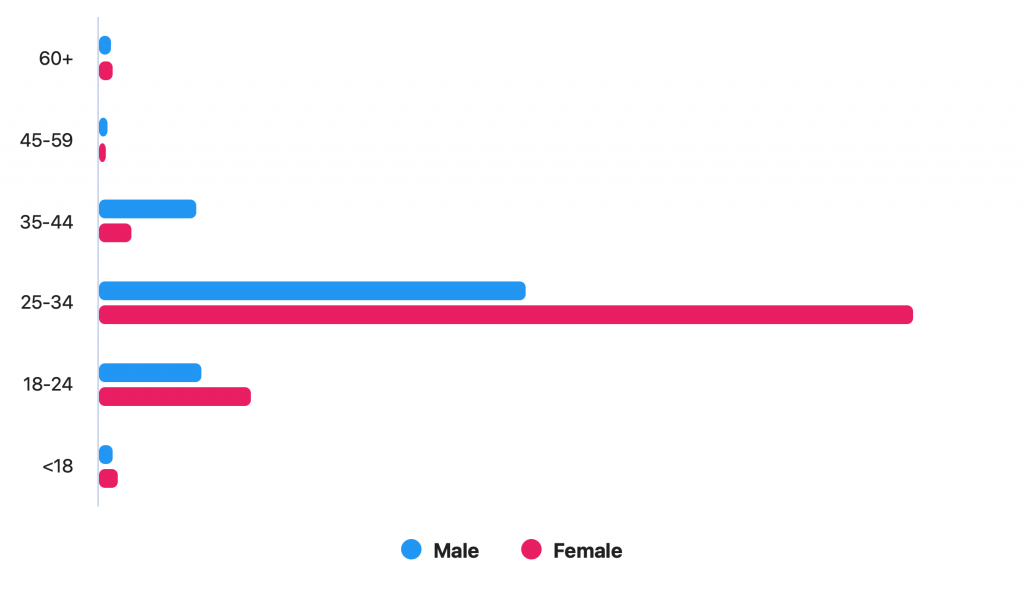
As we would expect the United States dominates the conversation, but if you look at this map of mentions, you’ll see that very few regions of the world remain untouched by pumpkin spice (including those south of the equator who aren’t even in the same season).
Different Channels, Different Conversations
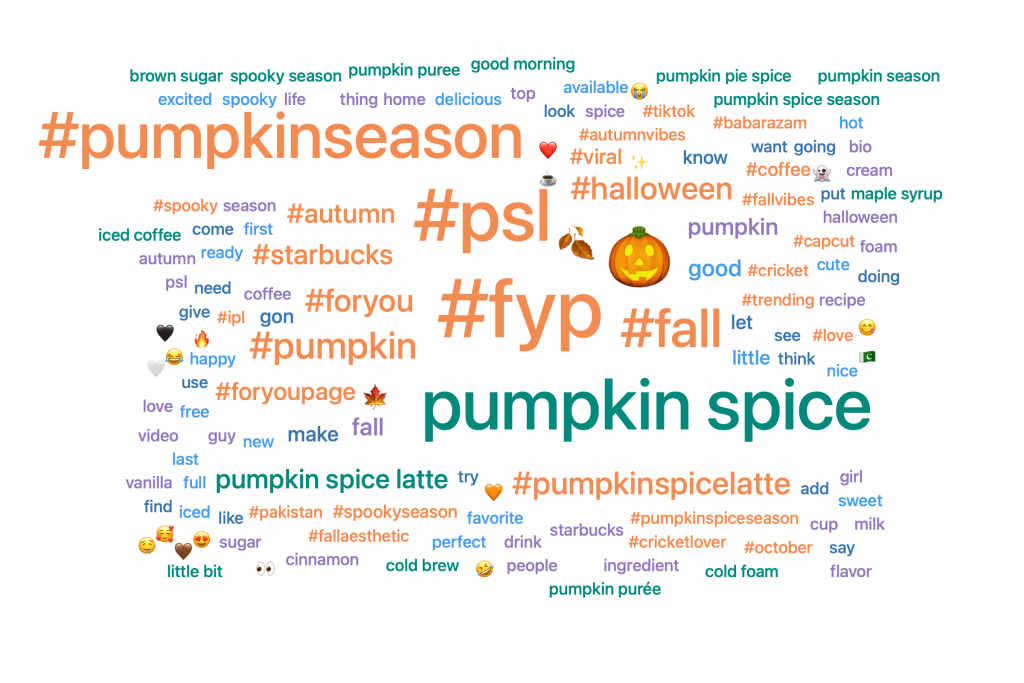
When we look at the most used keywords, tags, and terms on TikTok (home of engagement) versus Twitter (home of less engagement and more bad brand content) we can see immediately that on TikTok pumpkin spice is part of the overall Autumn/Fall vibe. While yes, there are many people talking about pumpkin spice latte, there are more people talking about #pumpkinseason is general.
On Twitter however, the conversation is dominated by the pumpkin spice latte, and littered with brand mentions, competitions, and sponsored posts.
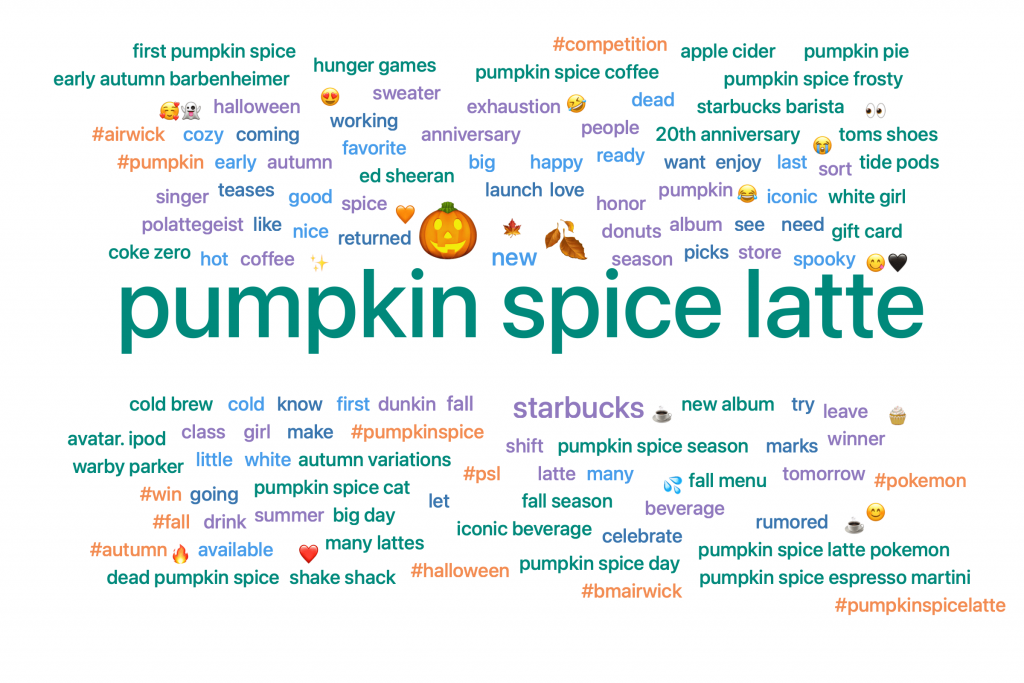
This isn’t to say that there isn’t Starbucks-related content on TikTok, there is, loads of it. It just comes primarily from users and feels like it lives on the platform; see the TikToks below:
Do Starbucks still own Pumpkin Spice Season?
It seems the answer to this is a resounding yes!
Although brand mentions are typically low in social conversation, Starbucks still accounted for a whopping 12% of the overall conversation. This is just brand text mentions, and doesn’t count for image analysis. So yes. Starbucks created, supported, and still own Pumpkin Spice Season.

How does This Social Phenomenon Translate to Search?


So now we understand what’s happening on social, but how does it translate to search?
Using Exploding Topics I’ve looked at some of the key search topics associated with pumpkin spice over the last five years.
At this stage it’s worth bearing in mind that this data is from Google, and those under 30 are increasingly using social for search, so this data is probably more representative of an older audience and may be responsible for the downturn in recent search results.
Starbucks Pumpkin Spice Latte is still the most searched-for term by far, and although the number of searches peaked in 2019, the trend has re-emerged every year since, as soon as the first hint of Fall is in the air, and it’s been holding pretty steady since.
Another similarly spiky trend is Pumpkin Spice Candles, which have experienced almost 5000% search growth in the last five years. This also appears to be on the decline now, but we can’t say for sure that it’s not just a reflection of the shift towards social search that we’re seeing. (we saw 45k posts around pumpkin spice recipes of DIYs within our search, and I didn’t include Pinterest, where much of this content lives, so the amount is likely much higher.)
Healthier Pumpkin Spice?
Although most of the conversation is still around sugar and dairy-filled treats, we’re starting to see more established healthier brands capitalise on the season, with pumpkin spice oat milk and creamer containing actual pumpkin. This suggests that either pumpkin spice is moving away from its ‘basic’ perception. Or there’s an overlap between ‘basic’ and healthier living.

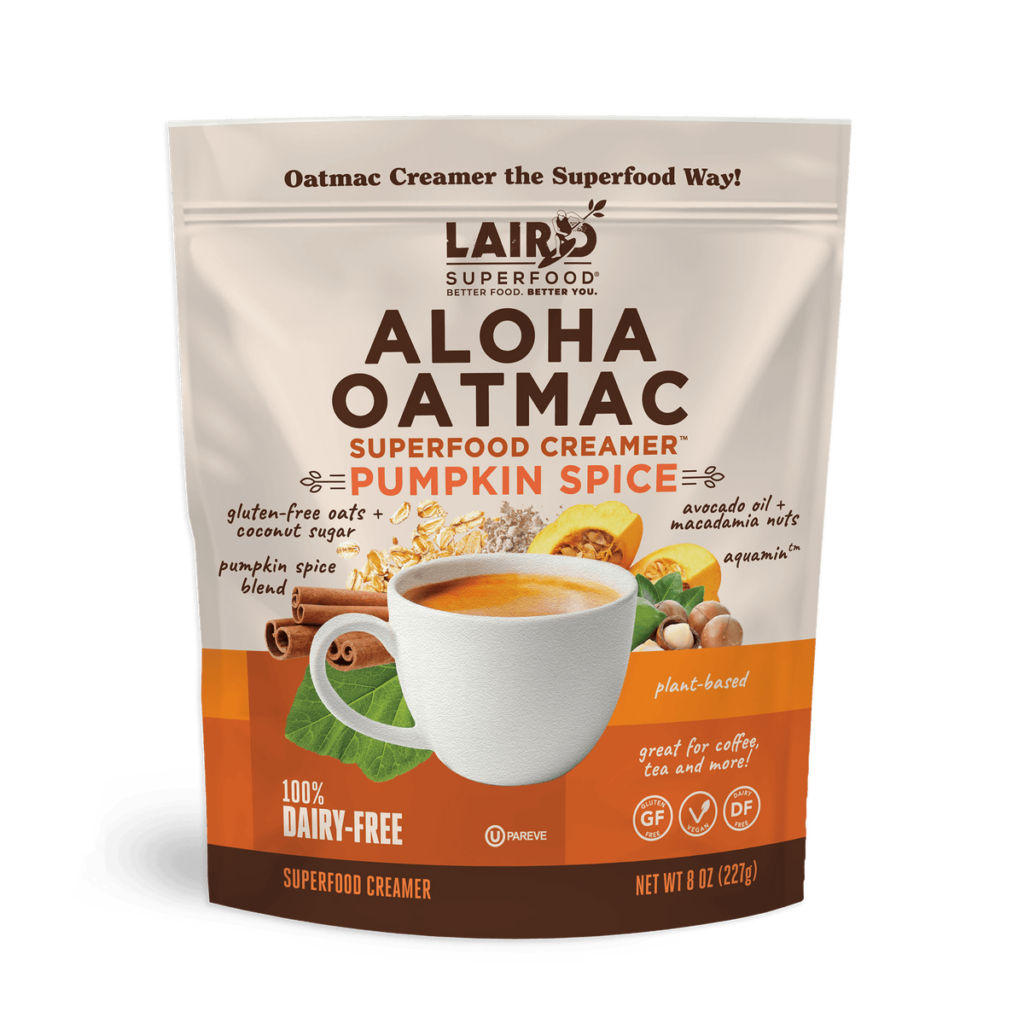

How is this data useful?
Eventually! the TL: DR
There are hundreds of applications for social listening data from a search like this. Here I’ve outlined four use cases that I use frequently in client work.
1: Understanding who your audience is
I will die on this hill. Understanding who your audience is is the key to all good brand work. It’s imperative for social and content strategy, It aids your R&D, it can be applied to multiple different business areas. This is the first and biggest reason to run any social research. The more brands do this, the more resonant the content they can create is, which leads to happier consumers and happier brands.
2: What is your whitespace?
Thinking about launching a new product, but want to know which areas are up and coming, which are overcrowded, and what your positioning might be?
Using a combination of social and search data, you’ll be able to get a much deeper understanding of what your next move should be. Don’t rely on generic trend reports from last year, do your own up-to-the-minute research, and you won’t be sorry!
3: Timings & context
You’ve got your product ready to go, but how do you ensure you start talking about it at the right time to garner maximum attention? You don’t want to go too early, but you also don’t want to get lost in the noise, and you definitely don’t want to be too late.
Use social listening to understand the exact moment that’s right to launch on social. (And to understand the shape of the conversation this year, to adapt your key talking points to up-and-coming trends, and ensure you and your brand feel ‘of-the-moment’). You can also use the geo-specific data to plan different territory release dates, as we saw with the UK conversation peaks trailing the US.
4: Understanding wider cultural shifts
Up until now we’ve talked mostly about the use cases for social listening as primarily quite focused, but another brilliant use of social listening data on the longer term is to begin to get a grasp on what’s happening in culture at large. These shifts often begin on social (or at least this is the first trackable manifestation of them). Social can also help us understand what’s driving these changes, and the context soical allows means we can apply this data to longer term future planning.
I used data from YouScan, Exploding Topics Pro, and Pulsar Platform to create this post. As ever, if you’d like to talk to me about how I can help you with social analysis or strategy, please Get In Touch.


